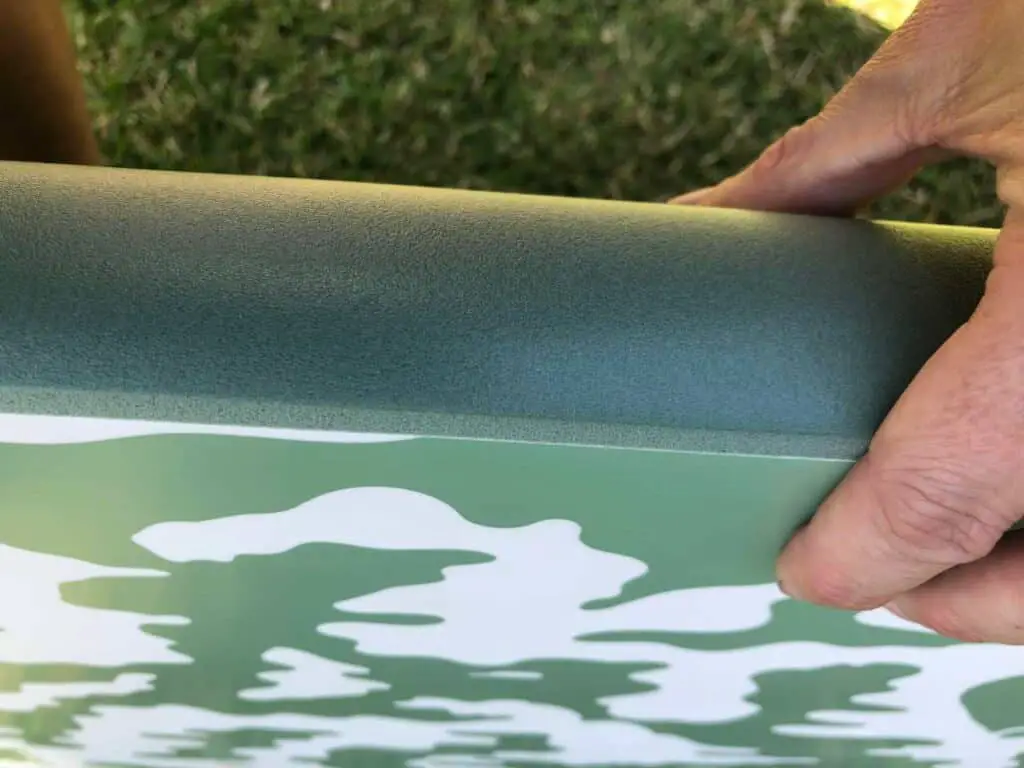
If you’ve ever wondered “what are surfboards made of”, one thing you can be sure of is that it’s a pretty complicated subject!
The way in which surfboards have been manufactured and the materials that have been used over the past 100 + years has changed enormously. As surfing has become so popular the volume of surfboards being produced and the highly toxic nature of production and overall environmental impact of their lifecycle is considerable. On the back of this, there’s been big push in more recent times to produce more sustainable surf craft and this is currently a major focus of the surf industry.
In order to logically put together this overview and to answer the question of what are surfboards made of, we’ve looked at the history of the surfboard getting to this point, the key materials that make up most surfboards, the general process of manufacturing and also a specific look at what soft top surfboards are made of and how they differ compared to traditional surfboards.
A short history of the surfboard
CIRCA 500 AD: Ancient Hawaiians ride boards as long as 15+ feet, made of wood from local trees and which were extremely heavy.
1778: Captain James Cook’s HMS Discovery on a stop in Hawaii, become the first recorded Europeans to witness surfing.
1907: Surfing makes its mainland USA debut during a publicity stunt during the opening event for the Redondo – Los Angeles Railway.
1926: Tom Blake – considered to be one of the most influential surfers of all time, drills holes in his 15 foot redwood board to reduce its weight, then encases it in two other pieces of wood. Some ridiculed him but in 1930 a version of his super-fast board becomes the first ever to be mass-produced. Seven years later, he publishes plans for a DIY board.
1932: The introduction of balsa decreases surfing board weights from 100 to 30 pounds
1934: Hawaiian surfers taper the tail end of their boards; the new, more hydrodynamic design allows them to manoeuvre into the curl of the wave and ride in the pipe.
1935: Blake creates the fixed-tail fin, which increases manoeuvrability and stability. (Twin fins hit surfboards in the late ’60s, triple fins aka thrusters in the early 80’s.)
1940’s TO 50’s: Fibreglass, invented in the 30’s, is used on surfboards after World War II. With the use of polyurethane or polystyrene foam covered with layers of fibreglass cloth, and polyester or epoxy resin, surfboards were now significantly lighter whilst still being strong, buoyant and manoeuvrable.
Recent developments in surfboard technology have included the use of carbon fibre and kevlar composites, as well as experimentation in biodegradable and ecologically friendly resins made from organic sources.

Foam Blanks
Polyurethane (PU)
With the introduction of polyurethane (PU) foam in the 1950’s surfboard builders quickly learnt it’s potential and together with a number of timely factors, surfing exploded.
PU blanks, fibreglass cloth and polyester resin became the standard method of surfboard construction and has remained so to this day. Before the closure in 2005 of Clark Foam, the world’s largest polyurethane blank manufacturer, the chemical-based core had a global market share of 90 percent.
One of the advantages is that it is light and very shapeable. If you look at it up close, it’s very fine and brittle so you can take sand paper and shave off corners without tearing into it. If you plan on buying a custom surfboard, most likely it’s made from Polyurethane.
However, one of the biggest downsides is its highly toxic nature. It has potential hazards to individuals working with these materials, possible contamination to the environment and they’re a non-renewable product. Following the closure of Clarke Foam in 2005, there has been an influx of new surfboard construction and use of different composites in surfboard construction.

Polystyrene (PS)
The polystyrene foam core is an alternative material that gained new supporters since the closure of Clark Foam. Polystyrene blocks are traditionally lighter and less resistant than polyurethane and are cut using a hot or fast wire technique to create a smooth cut.
Polystyrene surfboards are also greener than their polyurethane counterpart, and stringless models are increasingly popular.
The negatives of PS Foam however are it takes about 2-4 times the labour to shape and it is not as strong as PU foam. Polyester resin which has long been used to seal fibreglass onto PU foam blanks actually dissolves PS foam, so epoxy resin is used in its place with PS foam blanks.
Expanded Polystyrene Foam (EPS)
A version of polystyrene that features small foam balls, in a close. It is an extremely light and buoyant material (lighter than PU and PS foam) and as such, the negative of this is that its very difficult to shape by hand.
As a result, surfboards made out of EPS foam are usually molded by shaping machines commonly referred to as ‘pop outs’. EPS surfboards are the most environmentally sustainable choice.
Epoxy resin is the only skin resin that can be used with expanded polystyrene surfboards.

Extruded Polystyrene (XTR or XPS)
The extruded foam core is a 100 percent closed cell foam that does not absorb water, even if dinged.
It offers great flex memory, ensures high resistance to strong impacts, and it doesn’t feel too rigid to ride.
XTR surfboards have a superb responsive feel, but they’re too expensive to produce.
Density vs. Buoyancy
When choosing a surfboard, one important aspect of performance to consider is weight. A lighter board means more buoyant, floatable and maneuverable. When you compare three boards, made from the three different types of foam, the lowest density or lightest board will float you the best.
The advantageous of better buoyancy is great for paddling and allowing you to ride a smaller board for maneuverability. Each type of foam can have different density levels depending on how much the material has been compressed. Typically EPS is the lightest of the three and Polystyrene is lighter than Polyurethane foam.
However you might also want to weigh your decision on the durability of the surfboard as well. Polyurethane surfboards are the easiest to repair. EPS foam core is less likely to deteriorate over time and companies like Surftech with their epoxy fiberglass shell tout that their boards will last longer than traditional Polyurethane fiberglass surfboards.
A quick note about mistakenly used terms: “fibreglass” and “epoxy” boards
EPS and XPS boards are sometimes erroneously referred to as “epoxy boards”, while PU boards sometimes are erroneously referred to as “fiberglass boards”. These designations are not correct. Firstly, fiberglass is the most common skin for all the mentioned foam types. Secondly, PU foam boards can also be constructed using epoxy resin.
Aside from fibreglass, other surfboard skin materials used are bamboo, carbon fiber, hemp kevlar and innegra.
Polyester (PE) resin & PU/PE boards
Approximately 80% of the boards made today are finished using layers of fibreglass cloth sealed with polyester resin. This is due to it being more practical and economical than epoxy resin. In the manufacturing process, the polyester is mixed with a catalyst so that the resin stays consistent. The catalyst can be liquid or ultraviolet.
Most commonly, polyester resin and fibreglass has been used with PU Foam blanks (as PE eats into EPS foam and therefore can’t be utilised).
The benefits of PU/PE boards
- More affordable (than EPS/Epoxy).
- They sit a little lower in the water and more knifey feel
- Can really dig in to the wave for big clean carving turns
- Better at holding rail and barrel riding
- Slightly heavier – easier to get into waves and they handle choppy surf better
The Negatives
- Can dent more easily eg head imprints on the deck
- Boards look aged over time – the surfboard yellows due to the PE resin and repeated sun exposure
- Manufacturing process is quite toxic

Epoxy resin & expoxy boards
Epoxy boards are a combination of polystyrene foam (PS) or expanded polystyrene foam (EPS), fiberglass cloth, and epoxy resin, typically resulting in a lighter and more durable surfboard.
Read next – Soft Top vs Epoxy Surfboard
Positives of Epoxy
- Lightweight and strong due to the added stiffness of the epoxy resin compared to PE resin (and also due to less dense foam of EPS material)
- Very hardy and resistant to damage and the usual indentations (pressure) dents that you inevitably get with a PU/PE board.
- They have a unique feeling to surf on with a snappier feel. The foam produces what feels like a “floatier” board because of the increase in buoyancy. Epoxy boards typically have about 15-30% more floatability.
- EPS boards feel more on top of the water, paddle faster (as long as it’s not choppy), and many say are able to gain more speed from the wave. These three elements alone are enough to make an epoxy board a hit with surfers of every ability level.
- Another benefit of epoxy boards is that they are more environmentally friendly, less toxic and can be cleaned with denatured alcohol. Further there is constant development and advancements with different types of epoxy.
The Negatives
- In windy or choppy conditions epoxy boards do not perform as well due to their lightness. You will find the board lifting and bouncing around which fundamentally gives you less control.
- Some surfers prefer the performance and feeling of a PU/PE surfboard
- Epoxy surfboards are generally more expensive

Alternative surfboard construction types
Carbon
Carbon materials are being used in all styles of surfboard from high performance shortboard to longboard and even stand up paddle boards. Utilising EPS (expanded polystyrene) foam blanks, covered with a carbon fabric and epoxy resin provides a lightweight board which is super strong.
Balsa
Being light and strong, balsa wood was long considered a perfect material for surfboards, however shapers could not use this fragile wood to make entire surfboards until after WWII, when fiberglass skins were invented.
Balsa wood boards are lighter, more buoyant and easier to handle than other boards. These boards have some disadvantages, however: they are not as sturdy as solid redwood boards.
Hollow Wooden
Hollow wooden surfboards are made of wood and epoxy or oil (as a sustainable alternative to epoxy) and specifically have no foam in their construction (Boards made with foam and wood are commonly known as compsands or veneer boards).
Various construction methods are used to hollow the inside of the surfboard and lighten the weight of the completed board. Generally, a hollow wood surfboard is 30% to 300% heavier than a standard foam and resin surfboard. The main inspiration, apart from beauty, is that this is a more environmentally friendly method of construction (compared to epoxy and polyurethane methods) which uses fast-growing plantation wood such as paulownia, cedar, spruce, redwood, and, of course, balsa.
Cush – skinned
One of the more recent modern advancements in surfboard technology is the creation of high performance boards which are wrapped in a stretchable soft skin which does not absorb water. To be clear these are not soft top surfboards. Custom hand-shaped or machine shaped epoxy builds are sheathed in an eighth inch of vinyl. To ensure a tight bond the vinyl (about the thickness of 2mm wetsuit) is vacuum sealed. The rails are made of a stiff memory foam composite. The whole board is then coated with urethane.
Composite Sandwich Construction
The Composite Sandwich type of board construction became popular among garage shapers and later, major manufacturers, during the 1990s and 2000s. This construction method entails hand or machine shaping a foam blank from EPS foam and then vacuum bagging or hand laminating a more dense layer of foam, wood, or carbon onto the bottom and deck of the EPS foam core, usually separating the two layers with lightweight fiberglass cloth or other composites cloths.
This can also be accompanied with parabolic rails made of balsa or other buoyant woods, carbon, or other high-density materials. This blank construction is then laminated with epoxy resin and fiberglass or other composite cloth as any other surfboard would be, by hand or via vacuum bag.
The construction is referred to as a sandwich as it consists of the top skin, fiberglass or other composite cloth, the EPS core, fiberglass or other composite cloth, and the bottom skin, the cross section of which appears as a sandwich with the different layers. Firewire Surfboards pioneered this technology for the mass-produced surfboard market beginning in 2006.
Other materials used in surfboards
Stringers
If a stringer is used in the design, it is usually made of wood such as redwood, basswood, or spruce. Colored fiberglass stringers can also be used.
The “stringer” is a board’s central plane of reflection, down the middle of its deck and its keel. In construction, the stringer can have no special parts, or can embed a stiff, thin, vertical slat, usually of wood but sometimes of carbon fiber, running from nose to tail. The stringer serves to increase the board’s overall strength and reduce its flexibility. Some boards have multiple stringers.
Fins
Surfboard fins are typically made of laminated layers of fiberglass and resin, wood or plastic.
The manufacturing process
Here we outline a standard technique of construction for a single surfboard. Techniques and materials vary but the process is similar.
1. Forming the foam core
The foam blank is formed in a large, cement mold roughly the shape of the surfboard. The mold is constructed in two halves, and the inside is lined with a special paper that keeps the foam from sticking to the mold. The two halves are clamped together and the mold is heated. When the liquid polyurethane chemicals are poured into the mold, the heat triggers a chemical reaction which begins forming a dense, white foam. Surfboard builders call this process “blowing the blank.” After 25 minutes, the mold is opened and the foam core is taken out and allowed to finish hardening.
2. Adding the stringer
Once the core is hard, it is cut in half vertically from the nose to the tail. A thin stringer is glued between the two halves, and the core is then clamped back together to dry. Stringers provide stiffness and help keep the board from breaking in half.
3. Shaping the blank
The outline of the finished board is traced onto the rough core using a wooden template as a guide. The outline is then cut out with a saber saw. Starting with the bottom of the blank, the surface is smoothed and contoured to its final shape with a power planer. There are no templates or automatic machines to do this job, just the trained eye and experienced touch of the surfboard builder.
When the bottom is finished, the board is flipped over and the top is shaped. A power sander removes any ridges left by the planer, and the stringer is contoured with a hand plane. Rough sandpaper is used to shape the sides, or rails. The blank is given a final sanding with fine paper and the position for the fin is marked.
4. Laminating the outer shell
The shaped blank is now ready to be covered with fiberglass and resin to form the hard, outer shell of the surfboard. First, the blank is blown clean with compressed air. If the board is to be colored or have a design on it, acrylic paint is applied directly to the foam with a spray gun or air-brush. When the paint is dry, fiberglass cloth is laid over the surface of the blank and cut to fit.
Find out – Can you paint a surfboard?
The top of the board, or deck, is laminated first. A polyester resin, known as a laminating resin, is mixed with a second chemical called a catalyst. This starts a chemical reaction which will cause the resin to harden in 15 minutes. The resin is poured over the fiberglass and spread evenly using a rubber squeegee. All of the fiberglass must be covered without leaving too much or too little resin in any spot. This process is known as glassing.
When the deck is finished, the board is flipped over and the process repeated on the bottom. The board is then flipped once more, and the deck is given a second layer of fiberglass and resin for added strength and wear resistance. The laminating resin remains slightly tacky and rubbery when dry.
5. Applying the filler coat and adding the fin
A second coat of resin, called the filler coat or sanding resin, is applied next. The filler coat fills any surface imperfections left in the laminating resin. Sometimes, this coat is called a hot coat resin and contains wax. In either case, this resin contains a slightly different mix of chemicals which cause it to harden completely. The deck is coated first and the board is flipped over.
The fin is secured with fiberglass tape and a laminating resin. When the fin resin is dry, the bottom of the board and the fin are given a filler coat. When both sides are dry, a small hole is drilled through the tail to attach the leg leash.
6. Sanding the board
Any excess resin must be carefully sanded away. A power sander is used for the broad surfaces, but the rails and other sharply contoured surfaces are hand sanded to avoid gouging into the fiberglass layer.
7. Final finishing
The board is blown clean with compressed air to remove any residual sanding dust. On some boards, decals or color graphics are added at this point. A final coat of gloss resin is then brushed onto the board. Like the other two layers of resin, this final gloss coat is mixed with a catalyst and will harden within 15 minutes. The board is set aside for at least 12 hours to allow the gloss coat to completely harden. As a final step, the board may be wet sanded with very fine sandpaper, then rubbed, buffed, and polished.
What are soft top surfboards made of?
Blank formation
Like a regular surfboard blank, a soft top starts with a digital design created in a CAD program. A CNC milling machine than takes a larger square piece of EPS foam and cuts it into the specified shape (this is where the term pop out surfboards comes from).
After the blank leaves the cutting machine it needs some manual sanding to smooth out any imperfections.
Wrapped Core
Some foam boards, usually the more high-end ones, have a layer of fiberglass. The blank will be wrapped with one or more layers of 6 oz fiberglass cloth sealed with epoxy resin. This makes the board more stiff which means it is more durable, more responsive and will surf more like a regular hard board, which while not so important for an absolute beginner is important for any intermediate to advanced surfers who want more out of their board.
Key difference to regular surfboards
The biggest difference in the manufacturing between a regular hard surfboard and a soft top is the soft top layer. A foam surfboard has a soft, dentable EVA + PC top layer where a rigid surfboard has a hard fiberglass top layer.
The outer EVA layer (Ethylene-Vinyl Acetate) is glued to the fiberglass or synthetic wrap of the foam core. Usually the board and its layers will be cured by a vacuum bag to equally distribute the pressure over the surface of the board.
The hard bottom side of foamies are typically sheets of high-density polyethylene (known as HDPE) which is one of the most versatile forms of plastics. On the positive HDPE can be sourced from recycled HDPE which some soft top brands are incorporating into their boards. Australia’s Spooked Kooks confirm that:
“100% of all High-density Polyethylene used in our boards is recycled post-consumer plastic waste. This includes the entire “slick” (underside of the boards), leash plug, fin boxes, fins and fin key”.
There are some exceptions – Surftech have a range of soft top surfboards that utilise fibreglass bottoms and have a performance factor almost on par with their non-soft versions.

Stringers
Most foam surfboards are made out of an EPS blank with wooden stringers. It is common for longer boards to have 2-3 stringers but most boards of good quality will have at least 1-2 even at shorter lengths.
Fins
Learner foamies usually have soft fins or soft edge fins. These are rigid plastic fins with bendable rubber edges to avoid injuries and dings. These entry-level boards will often have simple fin boxes that you can screw in on the top of the board.
The more performance oriented foamies generally have proper fin boxes (FCS or Futures) which allow any fins of your choice. During the shaping process holes are cut where the finboxes go later on. As one of the final steps the fin boxes are pushed into the holes in the soft top board.
We hope you have learnt something in this what are surfboards made of guide and if you have any questions, please feel free to let us know in the comments below!
